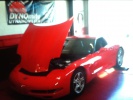Been reading around here quite a lot and I cannot find a lot of info on why my Trans seems so affected while trying to tune this cam. I have been dialing in VVE and the virtual torque tables, and the further I go and more refined they become the trans seems to get worse. I assumed this was based on the fact that the torque model was off but changing torque tables does not seem to be making the trans act any better. I feel that I have got VVE dialed in pretty well. I havent made any changes to the MAF since im still using the stock intake and the error has not been very far off, I figured it was probably fine to leave it as is.
I have recently gotten the converter rebuilt with a billet cover and internals to prevent converter death on the 6l80. I did install a Transgo Tow and Pro kit as well, which all worked out well. I did update the shift timing tables per Transgo's instructions, and have tried with an without these changes and it did not make a different to the jerking.
The goal of this build is to tow my camper with a little less stress, I also had a DOD lifter die and why would you keep a stock cam.

Sections of concern:
47s to 1:07: The trans is jerking in every gear here, it feels like when you drive a manual and are lugging the motor. Best description I can give.
1:34 to 1:38: Throttle plate is opening more then I would think it should, maybe this is ok?
4:14 to 4:17: I tried to roll on the pedal here and the truck didnt move at all.
- Stock bottom end L83
- DOD delete with TSP valley cover
- BTR Stage 2 Truck Cam
- Springs
- 4 Degree VVT limiter
- Hooker blackheart shorty headers
Any advice would be appreciated, I am at my wits end trying to get this thing to act correctly.





 Reply With Quote
Reply With Quote



